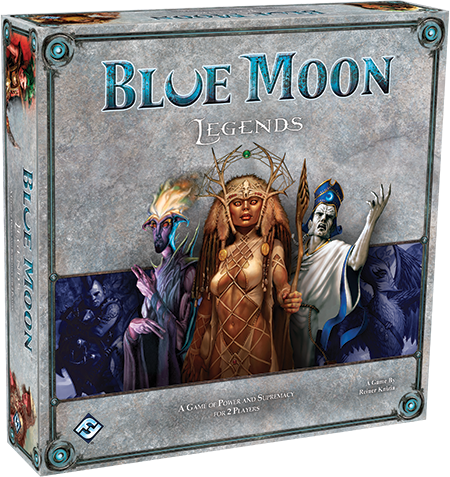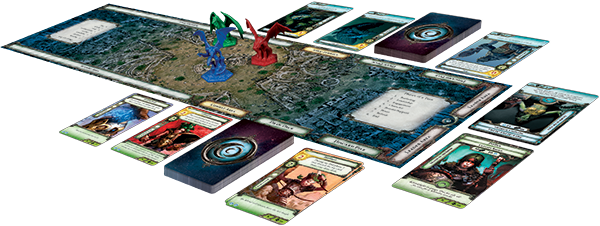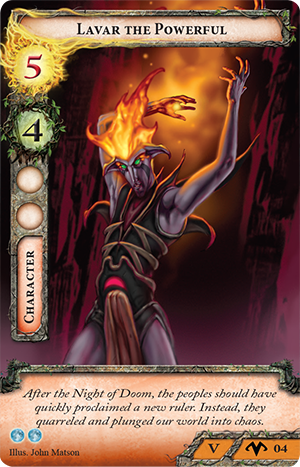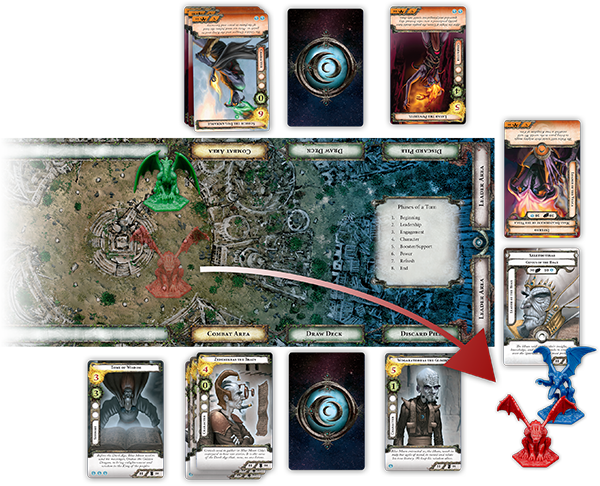
Secrets of Blue Moon
Preview Gameplay in Blue Moon Legends

The Night of Doom plunged Blue Moon City into chaos, casting the peoples into disarray. Now, two rival claimants lead the peoples against each other, attempting to win the favor of the elemental dragons through concentrated shows of power. Only a strong and wise leader can lead the peoples of Blue Moon City forward into a new era. In Blue Moon Legends, you have the chance to embody such a leader.
Blue Moon Legends is a collected version of Blue Moon and all of its expansions, an award-winning two-player card game created by renowned game designer, Reiner Knizia. For the first time, you have the chance to access Blue Moon and all of its expansions in one comprehensive edition. Whether you run with the fun-loving gangs of Khind, take to the skies with the Flit, or walk the trade routes of the Pillar, you’ll find a wealth of gameplay and deckbuilding opportunities enclosed in Blue Moon Legends.
Today, we will preview the structure of gameplay in Blue Moon Legends, including how to win fights and attract the attention of the elemental dragons to win the game.

Battles of Earth and Fire
The heart of gameplay in Blue Moon Legends is initiating and winning fights against your opponent. To begin a fight, you will play a character card from your hand, such as Lavar the Powerful. Along the upper left side of each character card, there are two numbers: the upper number is that character’s Fire power value, whereas the bottom number is its Earth power value, giving Lavar the Powerful a Fire value of five and an Earth value of four.
 The first player to begin a fight plays a character card and declares whether the fight will be contested in the element of Earth or of Fire. For example, if Fire is the contested element for a fight, only the Fire values on cards count towards your total power for the fight. After your opponent plays a character card and completes his turn, you must play a character card to continue the fight, and you have the option to add a booster or a support card from your hand. To keep the fight going, you must match or exceed your opponent’s power in the contested element. After playing cards in the fight on one turn, you draw from your deck until you have six cards in hand once more, and your opponent must now continue the fight or retreat.
The first player to begin a fight plays a character card and declares whether the fight will be contested in the element of Earth or of Fire. For example, if Fire is the contested element for a fight, only the Fire values on cards count towards your total power for the fight. After your opponent plays a character card and completes his turn, you must play a character card to continue the fight, and you have the option to add a booster or a support card from your hand. To keep the fight going, you must match or exceed your opponent’s power in the contested element. After playing cards in the fight on one turn, you draw from your deck until you have six cards in hand once more, and your opponent must now continue the fight or retreat.
The booster and support cards that you may play in fights allow you to enhance your side in some way. Boosters provide a temporary bonus to your side in the fight. For example, if you play Lavar the Powerful in an Earth element fight, your power would normally be four, but you can play Elemental Enchantment to increase your power to six for this turn. Boosters are temporary, lasting for only one turn, but support cards grant their bonus for the length of the fight. For example, the support card Wall of Fire keeps your opponent from drawing cards during the fight.
As both sides battle with ancient magics and powerful weapons, each new character card covers that player’s previous character card, giving the player a new power total. Covered characters and booster cards no longer count their power towards the fight, but support cards continue to have their effect on for the duration of the fight.
Of course, many characters, supports, and booster cards have special abilities that modify the outcome of any given fight. You can also bend the rules of engagement by playing leadership cards – powerful cards played at the beginning of your turn, representing the efforts of your people’s leader. Other cards have icons along the left border of the card that may help you achieve victory in combat. Cards with the retrieve icon, such as Ciklarethas the Bitter, can be returned to your hand from play at the beginning of your turn, allowing you to play him again over numerous turns of a fight. Other peoples possess their own special powers; the Khind gangs can band together in one fight and the seafaring Buka can use bluffs to increase their strength.
The Aftermath of the Contest
Eventually, however, one player will be unable to match or exceed his opponent’s power total in the contested element. When this occurs, the player who failed to continue the fight must retreat, leaving victory to his opponent. The player who did not retreat is rewarded by attracting a dragon. The dragons are more impressed by long-lasting fights, though, and if you have six or more cards in your combat area at the end of the fight, you attract one additional dragon. If all dragons are on the board between you and your opponent, attracting a dragon brings one dragon over to your own side, but if any dragons are on your opponent’s side, attracting a dragon returns one of those dragons to the game board. Any dragons on your opponent’s side must return to the game board before you can attract any to your own side.

Once dragons have been attracted, all cards in the combat area are discarded, and both players draw back to their full hand size of six cards. Then, the player who retreated has the opportunity to start a new fight by playing a character card and naming the contested element.
The game ends either when one player wins a fight after attracting all three dragons, or when one player plays or discards the last card in his hand and deck. Whichever player has the most dragons on his side is the victor and the new ruler of Blue Moon City!
Blue Moon Legends offers tense fights between peoples, but it also expands your creativity by inviting you to create decks spanning peoples, inquisitors, mutants, and emissaries. Join us next time as we preview deckbuilding in this two-player card game, and preorder Blue Moon Legends at your local retailer today!
…
